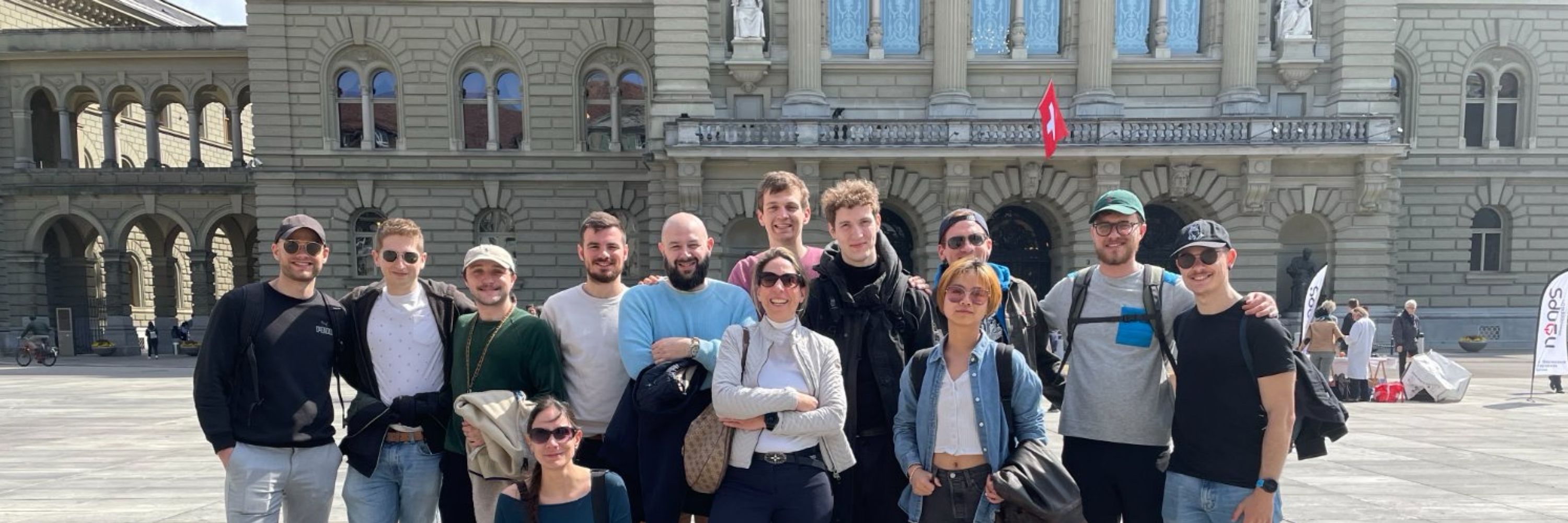

We provide a detailed walkthrough of how to implement #DCM partial integro-differential equation models - enabling accessible simulations of tissue patterning and morphogenesis.
arxiv.org/pdf/2509.08930

We provide a detailed walkthrough of how to implement #DCM partial integro-differential equation models - enabling accessible simulations of tissue patterning and morphogenesis.
arxiv.org/pdf/2509.08930
Quite fitting to see this novel idea that morphogen gradients not only encode position, but can also time & synchronise development over long distances out in a new journal.

Quite fitting to see this novel idea that morphogen gradients not only encode position, but can also time & synchronise development over long distances out in a new journal.
Spatially varying cell attraction that changes with tissue growth can guide migrating cells, leading to precise large-scale patterning.
This mimics how tissues form rings, bands, or layered structures in vivo.
👇Thread 🧵(9/11)

Spatially varying cell attraction that changes with tissue growth can guide migrating cells, leading to precise large-scale patterning.
This mimics how tissues form rings, bands, or layered structures in vivo.
👇Thread 🧵(9/11)
1. #Anisotropic #attraction
Cells pulling or migrating more strongly in one direction form aligned stripe-like patterns—e.g., during directional tissue growth.
👇Thread 🧵(8/11)

1. #Anisotropic #attraction
Cells pulling or migrating more strongly in one direction form aligned stripe-like patterns—e.g., during directional tissue growth.
👇Thread 🧵(8/11)
But biological tissues often require oriented patterns to fulfill specific functions.
Can DCM produce stripes, too?
👇Thread 🧵(7/11)

But biological tissues often require oriented patterns to fulfill specific functions.
Can DCM produce stripes, too?
👇Thread 🧵(7/11)
• Initial density of motile cells
• Intercellular attraction strength
• Cell sensing radius
👇Thread 🧵(6/11)

• Initial density of motile cells
• Intercellular attraction strength
• Cell sensing radius
👇Thread 🧵(6/11)
👉 1D, 2D, 3D
👉 arbitrary geometries & boundary conditions
👉 isotropic & anisotropic interactions
👉 fast, large-scale simulations
🧵(4/11)

#DCM offers a particularly fast and versatile route to spontaneously symmetry breaks and pattern formation without tissue buckling.
🧵(2/11)

#DCM offers a particularly fast and versatile route to spontaneously symmetry breaks and pattern formation without tissue buckling.
🧵(2/11)
Let’s explore a powerful and underappreciated mechanism: Directed Cell Migration (DCM).
Preprint @biorxivpreprint.bsky.social : doi.org/10.1101/2025...
👇Thread 🧵(1/11)
Let’s explore a powerful and underappreciated mechanism: Directed Cell Migration (DCM).
Preprint @biorxivpreprint.bsky.social : doi.org/10.1101/2025...
👇Thread 🧵(1/11)
Classical PINNs stall. PINNverse keeps improving physics loss ∼ epoch^(-1.4) for Fisher’s equation.
Algebraic decay >> stagnation!

Classical PINNs stall. PINNverse keeps improving physics loss ∼ epoch^(-1.4) for Fisher’s equation.
Algebraic decay >> stagnation!
- High noise
- Terrible initial guesses
Stable & accurate where others fail (e.g., Fisher-KPP).

- High noise
- Terrible initial guesses
Stable & accurate where others fail (e.g., Fisher-KPP).
Standard PINNs miss non-convex Pareto fronts → overfit.
#PINNverse captures the entire Pareto front → balances physics + data perfectly.

Standard PINNs miss non-convex Pareto fronts → overfit.
#PINNverse captures the entire Pareto front → balances physics + data perfectly.
Classical PINNs use weighted-sum loss → often fails.
#PINNverse reframes it as constrained optimization → unlocks better solutions.
Small change, huge impact!

Classical PINNs use weighted-sum loss → often fails.
#PINNverse reframes it as constrained optimization → unlocks better solutions.
Small change, huge impact!
✅ beats Nelder-Mead & classical PINNs
✅ handles noisy data & bad initial guesses
✅ tested on 4 tough benchmarks:
- Kinetic reaction ODE
- FitzHugh–Nagumo
- Fisher–KPP PDE
- Burgers’ PDE

✅ beats Nelder-Mead & classical PINNs
✅ handles noisy data & bad initial guesses
✅ tested on 4 tough benchmarks:
- Kinetic reaction ODE
- FitzHugh–Nagumo
- Fisher–KPP PDE
- Burgers’ PDE
No forward solves. Better accuracy. Robust to noise.
Preprint: doi.org/10.48550/arX...
#SciComm #MachineLearning #InverseProblems #PINNs

No forward solves. Better accuracy. Robust to noise.
Preprint: doi.org/10.48550/arX...
#SciComm #MachineLearning #InverseProblems #PINNs
News & Views "Tissue wrinkles foreshadow cancer" doi.org/10.1038/s415...

News & Views "Tissue wrinkles foreshadow cancer" doi.org/10.1038/s415...
authors.elsevier.com/a/1kXJ6Fzn7S...

authors.elsevier.com/a/1kXJ6Fzn7S...
These principles operate during both development and disease, providing a dynamic framework to understand and predict lung remodeling processes.
👇Thread 🧵(9/9)

These principles operate during both development and disease, providing a dynamic framework to understand and predict lung remodeling processes.
👇Thread 🧵(9/9)
Our biophysical model explains the thickening of the airway walls, potentially helping to localize affected areas, and yields quantitative #biomarkers for #PersonalizedHealth.
👇Thread 🧵(8/9)

Our biophysical model explains the thickening of the airway walls, potentially helping to localize affected areas, and yields quantitative #biomarkers for #PersonalizedHealth.
👇Thread 🧵(8/9)
⇨ Fluid–structure interactions act as powerful mechanisms for transmitting information continuously across scales.
👇Thread 🧵(7/9)

⇨ Fluid–structure interactions act as powerful mechanisms for transmitting information continuously across scales.
👇Thread 🧵(7/9)
Branch morphology adapts plastically depending on tip number, illustrating how local cues drive efficient lung formation.
👇Thread 🧵(6/9)

Branch morphology adapts plastically depending on tip number, illustrating how local cues drive efficient lung formation.
👇Thread 🧵(6/9)
We developed #SkelePlex, an #opensource tool for tracking bronchial tree growth & regeneration.
Validated on:
🐭 Mouse development
🐶 Dog lung regeneration post-surgery
🧑⚕️ #COPD patient cohorts
👇Thread 🧵(5/9)

We developed #SkelePlex, an #opensource tool for tracking bronchial tree growth & regeneration.
Validated on:
🐭 Mouse development
🐶 Dog lung regeneration post-surgery
🧑⚕️ #COPD patient cohorts
👇Thread 🧵(5/9)
This universal, #scaleinvariant mechanism enables lungs to function efficiently across species—whether in mice 🐭, dogs 🐶, or humans 🧑⚕️.
👇Thread 🧵(4/9)
This universal, #scaleinvariant mechanism enables lungs to function efficiently across species—whether in mice 🐭, dogs 🐶, or humans 🧑⚕️.
👇Thread 🧵(4/9)


